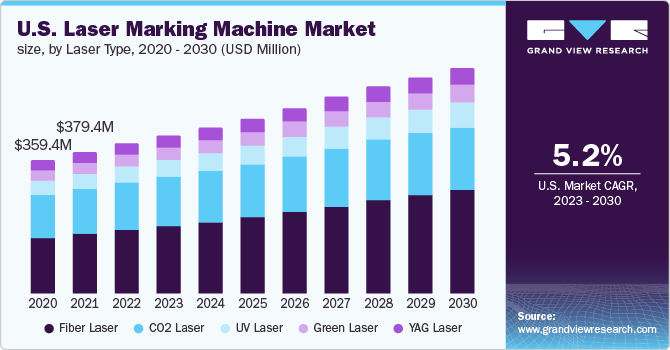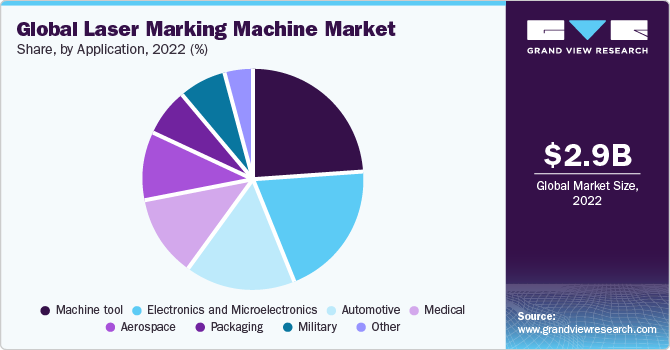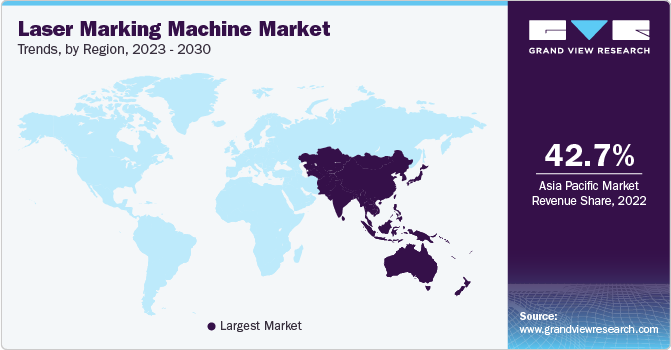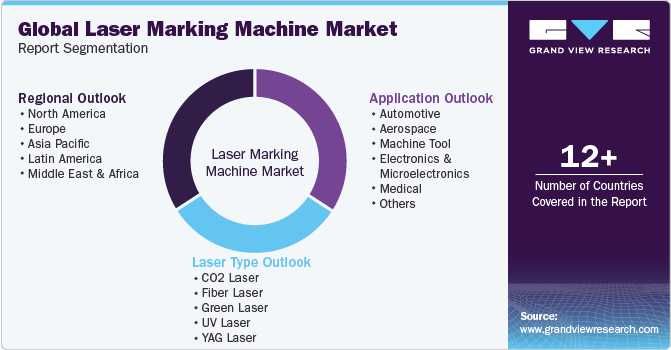- Home
- »
- Semiconductors
- »
-
Laser Marking Machine Market Size & Share Report, 2030GVR Report cover
![Laser Marking Machine Market Size, Share & Trends Report]()
Laser Marking Machine Market Size, Share & Trends Analysis Report By Laser Type (CO2, Fiber, Green, UV, YAG), By Application (Automotive, Aerospace, Medical, Packaging), By Region, And Segment Forecasts, 2023 - 2030
- Report ID: GVR-4-68038-448-2
- Number of Report Pages: 80
- Format: PDF, Horizon Databook
- Historical Range: 2017 - 2021
- Forecast Period: 2023 - 2030
- Industry: Semiconductors & Electronics
Laser Marking Machine Market Size & Trends
The global laser marking machine market size was valued at USD 2.95 billion in 2022 and is expected to grow at a compound annual growth rate (CAGR) of 7.9% from 2023 to 2030. The increasing adoption of laser marking machines in automation processes for mass manufacturing has positively impacted market growth. Laser marking systems are ideal for marking logos, bar codes, and matrix codes on almost all types of materials. In light of the COVID-19 outbreak, the medical sector witnessed a surge in the demand for laser marking machines and services. There was a very high demand for masks and certain other medical devices used for COVID-19 treatment during this period, and the adoption of laser marking machines by medical product and device manufacturers to mark their brand name and certifications grew strongly.

During the pandemic, there was also an excessive demand for COVID-19 testing kits with polypropylene tubes for sample collection. These kits are marked from outside using UV laser for different parameters to ensure that patient identification at any step is not compromised. The laser marking technology is increasingly being adopted across various industrial verticals due to its cost-effectiveness, product uniqueness, and reliability.
Administrations are instigating protocols for permanent marking on various products for proof of identity, traceability, and documentation purposes, especially in the healthcare and defense sectors. Furthermore, the automotive and aerospace industry is widely embracing the technology. In the automotive industry, markers are used for engraving serial numbers on tires without altering the tire structure. Compared to traditional engraving processes, laser marking is considered a versatile alternative for marking a wide range of aircraft parts since it offers high durability.
These engraving systems find extensive applications in the electronic devices industry. Products in the electronics and semiconductor industry are manufactured on a large scale and thus require automated marking and engraving procedures. These components are often labeled with a lot of information, which is done with the help of marking machines. For instance, 2D data-matrix codes are engraved on electronic components with the help of Galvo laser marking systems for a fully or semi-automated labeling process. Telesis Technologies, Inc. offers EV4GDS Green Laser System for high-speed marking on electronic components such as microchips, capacitors, and circuit boards.
The growing need for unique device identification and deep engraving during the manufacturing process for the purposes of traceability, inventory control, production flow control, and product quality validation is anticipated to fuel product demand. Markings done through these machines, especially fiber laser machines, consume less time and do not fade, even with continuous exposure to heat and harsh chemicals. Hence, the growing demand for such machines in the electronics and defense industries is further anticipated to bolster market growth during the projection period.
Additionally, the rising number of stringent government regulations and guidelines for markings on surgical and medical equipment to improve their traceability is projected to propel market growth for laser marking machines. A high demand has also been observed for personalized leather products, including leather jewelry, purses, and handbags, with customizations such as monogrammed initials and names. Hence, the demand from accessories & apparel industries is projected to drive demand growth for engraving technologies such as laser marking systems over the forecast period.
Laser Type Insights
The fiber laser segment accounted for the largest revenue share of 44.3% in 2022 and is expected to expand at the fastest CAGR over the forecast period. This is attributed to its various benefits such as flexible fiber light, high optical quality, high output power, and compact machine size. Apart from fiber lasers, other types of lasers considered in the study are CO2, green, UV, and YAG. Each machine uses different laser sources with different wavelengths; thus, each type of machine is used for a specific set of applications.
For instance, CO2 laser marking machines are typically used for thinner and lesser rigid surfaces, while fiber machines are used on more robust and hard surfaces. Hence, the wavelength of the laser source used in the machine plays an essential role in the selection of the machine type to be used for marking on a specific material. The increasing use of laser marking across varied applications such as aerospace and defense equipment, along with other metal equipment, has proved to be beneficial for market expansion.
The UV and YAG laser segments are expected to witness significant growth over the forecast period in the laser marking machine market due to their ability of fine cutting and micro-processing of specific materials such as glass, textile, ceramic liquid crystal screen, and others. The beam used in UV laser markings interacts with the material surface to alter its properties and appearance. The beam targets only a specific area to design or create high-quality, precise, and high-contrast markings.
Application Insights
The machine tool segment held the largest revenue share of 24.4% in 2022. The growing functionality of lasers to provide permanent alphanumeric details on machine tools, such as batch numbers, 1D & 2D bar codes, designs, dates of manufacturing, brand names, manufacturer codes, and logos, is fueling segment growth. The manufacturing sector is upgrading its operations with concepts such as factory automation and smart factories to improve its production capacity through batch production. Moreover, the increasing use of robotics and sensors has also highlighted the importance of tool identification and recognition, thus driving the demand for laser marking machines.

On the other hand, the aerospace segment is expected to expand at the fastest CAGR of 10.5% over the forecast period. The application of laser marking machines has witnessed a tremendous increase over the past few years on account of the growing demand for electronic products. Besides, electronic device manufactures are also focusing on the diversification of their product range to grab a larger share of the market, thus leading to an increase in the production of electronic devices, which positively impacts market growth.
Regional Insights
Asia Pacific dominated the market and accounted for a revenue share of 42.7% in 2022. Moreover, the region is expected to expand at the fastest CAGR over the forecast period. China and India are the major contributors to the growth of the regional market owing to the increased adoption of laser marking machines in manufacturing factories in the region. The market growth is primarily driven by the adoption of enhanced manufacturing techniques in the Chinese machine tools industry and the flourishing aerospace and military industry in the region.

Moreover, the continued regional dominance can also be attributed to the increased foreign investments and relocation of manufacturing facilities of numerous companies to countries such as India and China. For instance, the Belt and Road Initiative (BRI) (China) and Make in India initiative are attracting investments for infrastructural development, which, in turn, would enhance the manufacturing sector in these countries, thus generating strong demand for laser marking machines.
On the other hand, Europe is expected to witness a significant growth in this market during the forecast period, owing to the dominance of automotive and automotive component manufacturers in countries such as Germany, Europe, Italy, and France. Besides this factor, the considerable growth in the aerospace and shipping industries is expected to fuel market expansion in the region.
Key Companies & Market Share Insights
Key players in the market are increasingly investing in research and development activities to enhance their product offerings and gain a competitive edge over their counterparts. Leading vendors are focusing on providing enhanced marking systems to cater to the needs of a diverse set of customers and gain a more significant market share. Moreover, companies are also highly focused on strategic partnerships and acquisitions to expand their operations and product offerings to meet consumer demands.
For instance, in July 2022, II-VI Inc. acquired Coherent, Inc., a U.S.-based networking, materials, and laser systems and solutions provider. The integration of these two companies has resulted in a more diversified business across the value chain, spanning from materials to components, sub-systems, systems, and services. As a result of the merger, the combined entity has adopted the name "Coherent."
Key Laser Marking Machine Companies:
- Han's Laser Technology Industry Group Co., Ltd.
- Telesis Technologies, Inc.
- Videojet Technologies Inc.
- Trotec Laser GmbH
- Epilog Laser
- TYKMA Electrox
- MECCO
- LaserStar Technologies Corporation
- Gravotech Engineering Pvt. Ltd.
- Sea Force Co., Ltd.
Recent Developments
-
In April 2023, InnovMetric announced PolyWorks 2023, a new version that expands on the PolyWorks Universal 3D Metrology Platform. The new version introduced a fully featured digital ecosystem that integrates into all major stages in a manufacturer’s global dimensional management lifecycle: product design, process design, validation, and production. This advancement further strengthens PolyWorks’s position as the go-to solution for precision and quality across the manufacturing lifecycle
-
In August 2022, Foba made a significant announcement during the International Manufacturing Technology Show (IMTS) in Chicago. The company showcased its latest innovations by introducing two new laser marking systems: the Foba M1000 and M2000 from the M-series, along with the Foba Titus laser marking head, specifically designed for line integration, especially in limited spaces. These cutting-edge systems were available for live laser marking demonstrations at the IMTS event, providing attendees an opportunity to witness company’s advanced capabilities firsthand
-
In July 2022, Hitachi Industrial Equipment Systems Co., Ltd. announced the acquisition of Telesis Technologies Inc., a leading U.S.-based manufacturer specializing in marking equipment that utilizes laser technologies. With this strategic move, Hitachi has expanded its presence in the marking equipment market and strengthened its operations in North America
-
In May 2022, Gravotech introduced the LW2 laser marking workstation, a Class 1 fully secure solution designed to cater to diverse permanent marking and identification requirements. This advanced system promises an enhanced user experience and comes in various versions tailored to specific applications and individual needs
-
In April 2022, Hitachi Industrial Equipment Systems Co., Ltd. announced its acquisition of PHOTON ENERGY GmbH, a prominent German manufacturer of laser systems for marking purposes. This strategic move has allowed Hitachi Industrial Equipment Systems to bolster its position in the Coding and Marking industry by combining its existing strengths with the cutting-edge laser technological expertise of PHOTON ENERGY
Laser Marking Machine Market Report Scope
Report Attribute
Details
Market size value in 2023
USD 3.17 billion
Revenue forecast in 2030
USD 5.42 billion
Growth Rate
CAGR of 7.9% from 2023 to 2030
Base year for estimation
2022
Historical data
2017 - 2021
Forecast period
2023 - 2030
Report updated
November 2023
Quantitative units
Revenue in USD million and CAGR from 2023 to 2030
Report coverage
Revenue forecast, company ranking, competitive landscape, growth factors, and trends
Segments covered
Laser type, application, region
Regional scope
North America; Europe; Asia Pacific; Latin America; MEA
Country scope
U.S.; Canada; UK; Germany; France; China; Japan; India; Australia; South Korea; Brazil; Mexico; Saudi Arabia; South Africa; UAE
Key companies profiled
Han's Laser Technology Industry Group Co., Ltd.; Telesis Technologies, Inc.; Videojet Technologies Inc.; Trotec Laser GmbH; Epilog Laser; TYKMA Electrox; MECCO; LaserStar Technologies Corporation; Gravotech Engineering Pvt. Ltd.; Sea Force Co., Ltd.
Customization scope
Free report customization (equivalent up to 8 analyst’s working days) with purchase. Addition or alteration to country, regional & segment scope
Pricing and purchase options
Avail customized purchase options to meet your exact research needs. Explore purchase options
Global Laser Marking Machine Market Report Segmentation
This report forecasts revenue growth at the global, regional, and country levels and provides an analysis of the latest industry trends in each of the sub-segments from 2017 to 2030. For the purpose of this study, Grand View Research has segmented the global laser marking machine market report on the basis of laser type, application, and region:

-
Laser Type Outlook (Revenue, USD Million, 2017 - 2030)
-
CO2 laser
-
Fiber laser
-
Green laser
-
UV laser
-
YAG laser
-
-
Application Outlook (Revenue, USD Million, 2017 - 2030)
-
Automotive
-
Aerospace
-
Machine tool
-
Electronics and Microelectronics
-
Medical
-
Packaging
-
Military
-
Others
-
-
Regional Outlook (Revenue, USD Million, 2017 - 2030)
-
North America
-
U.S.
-
Canada
-
-
Europe
-
UK
-
Germany
-
France
-
-
Asia Pacific
-
China
-
Japan
-
India
-
Australia
-
South Korea
-
-
Latin America
-
Brazil
-
Mexico
-
-
Middle East and Africa
-
Saudi Arabia
-
South Africa
-
UAE
-
-
Frequently Asked Questions About This Report
b. The global laser marking machine market size was estimated at USD 2.95 billion in 2022 and is expected to reach USD 3.17 billion in 2023.
b. The global laser marking machine market is expected to grow at a compound annual growth rate of 7.9% from 2023 to 2028 to reach USD 5.42 billion by 2030.
b. Asia Pacific dominated the laser marking machine market with a share of 42.66% in 2022. This is attributable to the adoption of enhanced manufacturing techniques in the Chinese machine tools industry and the flourishing aerospace and military industry in the region.
b. Some key players operating in the laser marking machine market include Han's Laser Technology Industry Group Co., Ltd; Telesis Technologies, Inc.; Videojet Technologies, Inc.; Trotec Laser GmbH; Epilog Laser; TYKMA Electrox, Inc.; MECCO.
b. Key factors that are driving the laser marking machine market growth include higher penetration of electronic devices in regular households, increasing trend of automation in manufacturing processes, and increasing penetration across niche industry verticals.
Share this report with your colleague or friend.
![gvr icn]()
NEED A CUSTOM REPORT?
We can customize every report - free of charge - including purchasing stand-alone sections or country-level reports, as well as offer affordable discounts for start-ups & universities. Contact us now
![Certified Icon]()
We are GDPR and CCPA compliant! Your transaction & personal information is safe and secure. For more details, please read our privacy policy.
We are committed towards customer satisfaction, and quality service.
"The quality of research they have done for us has been excellent."





